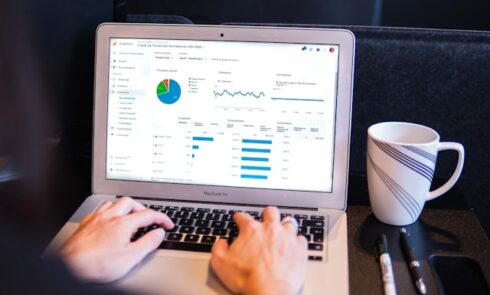Integrating 3D elements into web designs is an effective strategy for elevating visual appeal and crafting immersive user experiences. This approach is ideal for various online platforms, including product showcases, narrative visuals, and interactive, data-intensive reports. Despite their complex appearance, the incorporation of 3D visuals is simplified with the appropriate tools, allowing web developers to either create captivating 3D graphics or utilize the plethora of available 3D assets. However, it’s important to note that 3D elements typically generate large file sizes, which can adversely affect website loading speeds and overall performance.
Enter the utility of GLB files, your go-to solution for 3D web design needs. This guide covers essential information about the GLB file format, highlighting its benefits for web projects. Learn where to source GLB files and how to efficiently optimize them to enhance your web design projects without compromising site performance.
Understanding GLB Files
If you’re exploring the realm of 3D file formats, you may come across GLB files and wonder about their purpose. Introduced as a fresh file format in 2015, GLB represents “GL Transmission Format Binary file.” This format emerged to fill the gap for a flexible and easily manageable file type that could be seamlessly utilized across diverse 3D applications and graphic editing tools.
GLB files are repositories of intricate data such as 3D models, scenes, lighting setups, materials, hierarchical structures, and animations. In essence, they’re designed to support dynamic motion and complex animations, which makes them highly suitable for web-based applications, interactive games, as well as immersive virtual and augmented reality environments.
The inception of GLB files marked an evolution for glTF files, translating them into a binary form that improved their interoperability and efficiency on various platforms and within different software ecosystems.

Comparing GLB and glTF Files
Within the sphere of 3D digital assets, both GLB and glTF formats play pivotal roles by encapsulating static and animated content. The glTF format is particularly prominent in immersive applications such as virtual and augmented reality, interactive gaming, web-based applications, and even 3D advertising. These files also integrate smoothly into common office applications like Microsoft Word and PowerPoint, enhancing document and presentation interactivity.
Yet, for all their shared traits, GLB and glTF formats part ways in their core structure. GLB files are the compact, binary version of glTF files, which are typically structured in the readable JSON format. To put it in layman’s terms for those less versed in software or web development, think of GLB as a packed suitcase, neatly containing everything in one file, while glTF is like having your items laid out individually for you to see.
| glTF Files | GLB Files |
|---|---|
| Designed to reference external resources. | Encapsulate all necessary data internally. |
| Data components stored in separate external files. | All necessary data contained within a single file. |
| External file formats used for different data types (e.g., JPEG for textures, BIN for animation data). | No additional external files required for accessing and utilizing stored 3D content. |
Advantages of Using GLB Files for Web Design
While the formatting differences between glTF and GLB files may seem daunting, utilizing the GLB file format offers numerous benefits. Particularly in web design, GLB files excel in showcasing 3D motion and animation with efficiency and ease. With their relatively small file size, GLB files load quickly, making them ideal for VR and AR applications, CGI advertisements, and immersive web experiences like those found on platforms such as Facebook.
Moreover, there are several additional advantages to opting for GLB over glTF format, making them an optimal choice for integrating 3D elements into your web designs:
- Small file size: GLB files typically boast a 33% reduction in size compared to glTF and its accompanying files. This results in lower processing demands, smoother transfers, and faster loading times, which is particularly beneficial when working with mobile and web-based 3D modeling applications;
- All-in-one file format: Instead of dealing with the complexities of uploading multiple 3D files, GLB simplifies the process by consolidating all necessary data into a single binary file. This streamlines uploading to servers and reduces potential complications associated with managing multiple files;
- Instant interaction: Within a GLB file, essential components such as full textures, animation details, and a complete PBR shader are included. This means that users can instantly view and interact with all elements as soon as the file is opened, without the need for additional steps or processes.
How to Create a GLB File
Creating a GLB file from scratch or converting existing files into GLB format can be accomplished through various methods. One of the most straightforward approaches is the conversion of glTF files into GLB format. There are numerous online tools available for this purpose, including Creators 3D and AnyConv, among others, that facilitate this conversion process free of charge. Alternatively, if you’re not looking to convert a glTF file into a GLB, employing a glTF optimizer is a viable option. This optimizer will compress the file, thereby improving rendering and loading speeds while also reducing the file’s download size.
For those engaged in direct 3D project creation, utilizing 3D modeling software such as Blender is recommended. Prior to beginning, it’s crucial to gather all necessary components such as materials, lighting, models, node hierarchy, and animations within a single project file. With all elements prepared, you can proceed to export your 3D project as a GLB file. Blender stands out as an excellent tool for crafting 3D models, though it demands a significant level of proficiency and familiarity with the software. For individuals lacking the necessary skills or understanding of Blender, turning to external sources for 3D assets might be more suitable.
Moreover, it’s feasible to convert various other 3D file formats, including OBJ, FBX, and STL, into GLB files, and the reverse is also true. To verify the compatibility of specific 3D files for conversion, consulting File-Extensions.org is advisable. By inputting the desired file types and initiating a search, you can easily ascertain whether conversion is possible.
Where to Find Free GLB Files Online

Fortunately, there’s a wealth of readily available GLB files to enhance your web design projects with 3D elements without starting from scratch. Despite GLB’s niche status, locating free resources may pose a challenge.
To simplify your search, we’ve curated a list of reputable websites offering diverse GLB files, enabling swift downloads for immediate use in your designs:
- CGTrader: A hub hosting thousands of free 3D models and assets suitable for web design endeavors. While GLB options are abundant, you’ll also find a vast array of models in other popular formats;
- Sketchfab: Another valuable resource offering free 3D models, though with a more limited selection of GLB files compared to CGTrader. Additionally, their paid assets are reasonably priced, with some available for as little as $3 each;
- 3DExport: While boasting a smaller collection of free GLB models, 3DExport can be a valuable resource for specific needs. Should you not find the desired format, they offer conversion services upon request through a ticketing system.
Conclusion
GLB files stand as an innovative solution in the realm of 3D web design, offering compact, comprehensive, and efficient 3D visual data management. With their versatility, easy compatibility, and ample usage benefits, these files prove essential for web developers and designers to create vibrant and lively digital experiences. As we continue to see the evolution of 3D graphics, GLB files are set to play an increasingly pivotal role in crafting engaging, dynamic, and immersive web experiences, reshaping the way we perceive and interact online.

